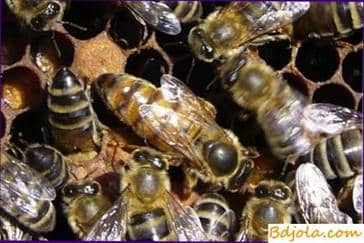
Go closer to the hive, and you will hear the noise of the family, deaf, even, unison. It is similar to the sound of boiling. It is the sound of everyday bee labor. After all, the bees are in the nest in constant movement and work, not knowing the day and night, in any weather. Some clean and polish the cells, others feed the larvae or seal them with wax, others finish the honeycombs, the fourth on the narrow streets make their way to honey and pollen to gain food or, conversely, to put it there. This is the non-stop rhythm and voice of a strong, happy, busy family.
Slightly tap your finger on the hive, and instantly follow a strict, alert, friendly response of disturbed and ready to protect nest of insects.
Honeybees emit and themselves perceive ultrasounds and oscillations in a hundred-thousandth of a millimeter, immediately reacting to them.
Disturbed noise, from which one, then in the other side of the nest are distinguished plaintive peppering voices, speaks of unhappiness in the family. She as if complains, asks for help. This is the voice of an orphaned, orphaned family.
In the single monotonous drone of the apiary, it is possible to distinguish the sounds of the busy bees of busy bees, the alarmed bees-sentries guarding their goods, the trumpeting bass of playing idle drones. Hence, the apiary lives its normal life.
In the time of the sword, when the outflow of the swarm is delayed due to bad weather, it is possible to distinguish the so-called singing of the queens – old and young. Strong, sharp, monosyllabic sounds of the uterus “pi-i-i-i-pi-pi-pi”, well audible even a few steps from the hive, threaten the pretender of the “throne”. This is a challenge to the battle. The high tone of the signals “pi” and the rapid movement of the uterus along the nest in search of a rival indicate a strong excitement and determination of the uterus-mistress.
The young, full of energy and strength of the uterus responds to her threats and challenges, while she is in the mother cell-cradle under the control and protection of bees. With her muffled “quasqua-kwa” she accepts the challenge and confirms that she is also ready for combat. The uterus seems to be talking, and almost never interrupting each other. Working bees calmly react to these recruiting bellicose threats. Huddled together, they do not allow a fight.
Singing of the queens is especially clear at the end of the day, in the evening before evening. This signal to the beekeeper: tomorrow there will be a new family – a swarm, we must prepare ourselves to not miss it. After all, it says, and swarm, so that the beekeeper does not doze. And before the release of the swarm you can hear sharp short sounds – a conventional sign of swarming.
There are many other sounds for bees, but they are not fully understood yet.
Learn to determine the state of the family.
The state of the bee family can also be determined by the behavior of the bees in the tap. An experienced beekeeper will go through the apiary, see how they work, and already knows what is happening in the hives. You can learn this if you are careful and able to observe.
Go to the hive and see how the bees work. Closely near the tap, the bees barely make their way to the nest. And next to another hive, bees fly rarely, they are easy to count. And it is not required to open the hives and dismantle the nests to find out which of these families is strong and which is weak.
Take a closer look. Bees arrive heavy, with a full belly. They do not sit down, but fall directly onto the board and not immediately, and after a short while they catch their breath, they slowly enter the summer. And most recently returning bees ran into the hive, not lingering on the board. What is the change talking about? The fact that a good honey harvest has started has blossomed some powerful honey, the bees have discovered it and are gathering nectar from it.
Try on the pollen update to determine which honey blooms. Remember: from the willow pollen is light yellow, from the dandelion – orange, from the apple tree – light green, meadow motley grass – more yellow, with clover – brown, with spraying – dark blue. But there are a lot of other medonos. To determine which plants give what pollen, you need to observe the bees on the flowers.
On the landing board between the bees, a fight starts. So bee stealing began – bees-scouts do not miss the opportunity to penetrate into another’s nest for honey. Apparently, too spacious.
If the hive has died down in the summer morning, the bees are cautious and at the tap, while other families have been working for a long time, a swarm should emerge from the nest as soon as the sun is warm. There are other signs, by which you can find out that soon the family will swarm. Try to install them yourself.
Sometimes near the tap hole you can find dead larvae. This is the most likely sign of family starvation or disease, if the larvae are browned and have a bad smell.
At the end of the summer, especially after the honey collection, the bees throw out the drone larvae. This indicates that the families began to prepare for the winter.
If the bees expel the drones, then the breeding season has ended. This sign also says that everything is all right in the family. Remember, when the uterus is barren or it is not at all, drones remain in the winter. Summer and board are a mirror of the family. Be careful when you approach the hive. Learn to determine the state of the family.
Щавелевая кислота и варроатоз. Как бороться от восковой моли.
Young Beekeeper